Toyota Avalon (XX50): Center Airbag Sensor Communication Stop Mode. Certification ECU Communication Stop Mode. Check Bus 1 Line for Short to +B
Center Airbag Sensor Communication Stop Mode
DESCRIPTION
|
Detection Item | Symptom |
Trouble Area |
| Center Airbag Sensor Communication Stop Mode |
Any of the following conditions are met:
- Communication stop for "Airbag" is indicated on the "Communication Bus Check" screen of the Techstream.
Click here 
- Communication stop history for "Airbag" is indicated on the
"Communication Bus Check (Detail)" screen of the Techstream. (The Lost
Communication Time value for "Airbag" is 6 or more.)
Click here 
- Communication system DTCs (DTCs that start with U) that correspond to
"Center Airbag Sensor Communication Stop Mode" in "DTC Combination
Table" are output.
Click here 
|
- Airbag ECU assembly main line or connector
- Power source circuit of airbag ECU assembly
- Airbag ECU assembly ground circuit
- Airbag ECU assembly
|
WIRING DIAGRAM
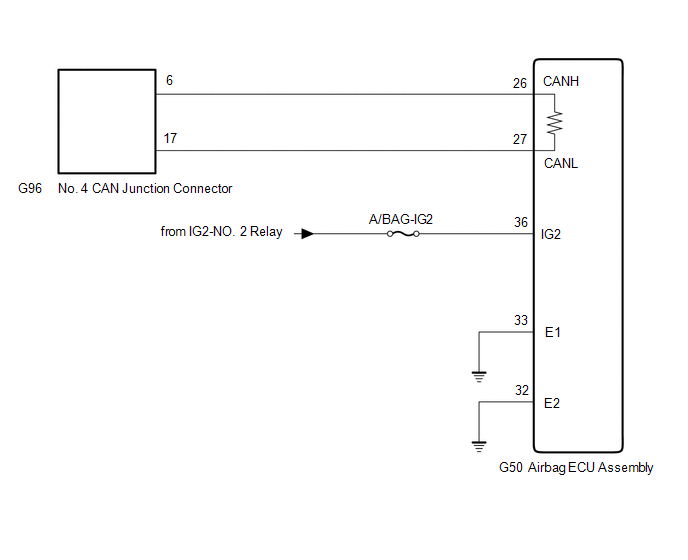
CAUTION / NOTICE / HINT
CAUTION:
When performing the confirmation driving pattern, obey all speed limits and traffic laws.
NOTICE:
HINT:
- Before disconnecting related connectors for inspection, push in on each
connector body to check that the connector is not loose or disconnected.
- When a connector is disconnected, check that the terminals and connector body are not cracked, deformed or corroded.
PROCEDURE
|
1. | CHECK FOR OPEN IN CAN BUS LINES (AIRBAG ECU ASSEMBLY MAIN LINE) |
(a) Disconnect the cable from the negative (-) auxiliary battery terminal.
(b) Disconnect the G50 airbag ECU assembly connector.
| (c) Measure the resistance according to the value(s) in the table below.
Standard Resistance: |
Tester Connection | Condition |
Specified Condition | |
G50-26 (CANH) - G50-27 (CANL) |
Cable disconnected from negative (-) auxiliary battery terminal |
108 to 132 Ω | |
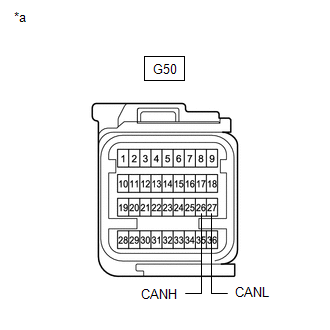 |
|
*a | Front view of wire harness connector
(to Airbag ECU Assembly) | | |
| NG |
 | REPAIR OR REPLACE CAN MAIN BUS LINES OR CONNECTOR (AIRBAG ECU ASSEMBLY) |
|
OK |
 | |
| 2. |
CHECK HARNESS AND CONNECTOR (POWER SOURCE CIRCUIT) |
| (a) Measure the resistance according to the value(s) in the table below.
Standard Resistance: |
Tester Connection | Condition |
Specified Condition | |
G50-32 (E2) - Body ground |
Cable disconnected from negative (-) auxiliary battery terminal |
Below 1 Ω | |
G50-33 (E1) - Body ground |
Cable disconnected from negative (-) auxiliary battery terminal |
Below 1 Ω | |
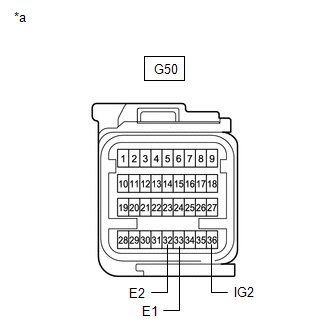 |
|
*a | Front view of wire harness connector
(to Airbag ECU Assembly) | | |
(b) Reconnect the cable to the negative (-) auxiliary battery terminal.
(c) Measure the voltage according to the value(s) in the table below.
Standard Voltage:
|
Tester Connection | Condition |
Specified Condition |
|
G50-36 (IG2) - Body ground |
Power switch on (IG) |
11 to 14 V |
| OK |
 | REPLACE AIRBAG ECU ASSEMBLY |
| NG |
 | REPAIR OR REPLACE HARNESS OR CONNECTOR (POWER SOURCE CIRCUIT) |
Certification ECU Communication Stop Mode
DESCRIPTION
|
Detection Item | Symptom |
Trouble Area |
| Certification ECU Communication Stop Mode |
Any of the following conditions are met:
- Communication stop for "Certification (Smart)" is indicated on the "Communication Bus Check" screen of the Techstream.
Click here 
- Communication stop history for "Certification (Smart)" is indicated on
the "Communication Bus Check (Detail)" screen of the Techstream. (The
Lost Communication Time value for "Certification (Smart)" is 6 or more.)
Click here 
- Communication system DTCs (DTCs that start with U) that correspond to
"Certification ECU Communication Stop Mode" in "DTC Combination Table"
are output.
Click here 
|
- Certification ECU (smart key ECU assembly) branch line or connector
- Power source circuit of certification ECU (smart key ECU assembly)
- Certification ECU (smart key ECU assembly) ground circuit
- Certification ECU (smart key ECU assembly)
|
WIRING DIAGRAM
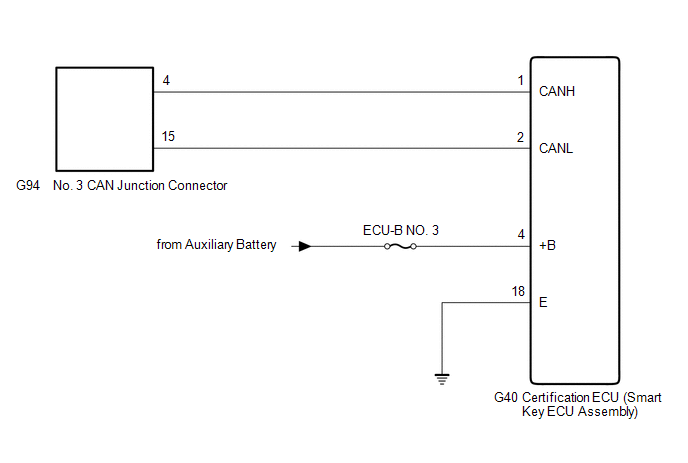
CAUTION / NOTICE / HINT
CAUTION:
When performing the confirmation driving pattern, obey all speed limits and traffic laws.
NOTICE:
HINT:
- Before disconnecting related connectors for inspection, push in on each
connector body to check that the connector is not loose or disconnected.
- When a connector is disconnected, check that the terminals and connector body are not cracked, deformed or corroded.
PROCEDURE
|
1. | CHECK FOR OPEN IN CAN BUS LINES (CERTIFICATION ECU (SMART KEY ECU ASSEMBLY) BRANCH LINE) |
(a) Disconnect the cable from the negative (-) auxiliary battery terminal.
(b) Disconnect the G40 certification ECU (smart key ECU assembly) connector.
| (c) Measure the resistance according to the value(s) in the table below.
Standard Resistance: |
Tester Connection | Condition |
Specified Condition | |
G40-1 (CANH) - G40-2 (CANL) |
Cable disconnected from negative (-) auxiliary battery terminal |
54 to 69 Ω | |
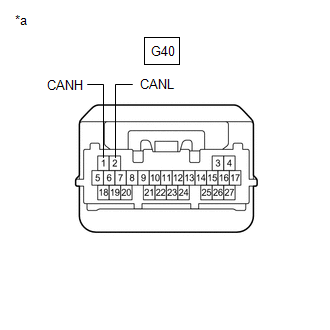 |
|
*a | Front view of wire harness connector
(to Certification ECU (Smart Key ECU Assembly)) | | |
| NG |
 | REPAIR OR REPLACE CAN BRANCH LINES OR CONNECTOR (CERTIFICATION ECU (SMART KEY ECU ASSEMBLY)) |
|
OK |
 | |
| 2. |
CHECK HARNESS AND CONNECTOR (POWER SOURCE CIRCUIT) |
| (a) Measure the resistance according to the value(s) in the table below.
Standard Resistance: |
Tester Connection | Condition |
Specified Condition | |
G40-18 (E) - Body ground |
Cable disconnected from negative (-) auxiliary battery terminal |
Below 1 Ω | |
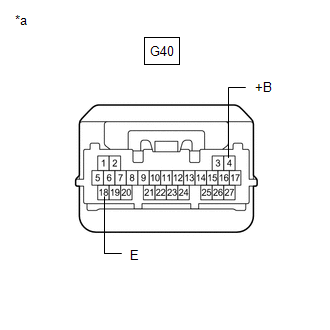 |
|
*a | Front view of wire harness connector
(to Certification ECU (Smart Key ECU Assembly)) | | |
(b) Reconnect the cable to the negative (-) auxiliary battery terminal.
(c) Measure the voltage according to the value(s) in the table below.
Standard Voltage:
|
Tester Connection | Condition |
Specified Condition |
|
G40-4 (+B) - Body ground |
Power switch off | 11 to 14 V |
| OK |
 | REPLACE CERTIFICATION ECU (SMART KEY ECU ASSEMBLY) |
| NG |
 | REPAIR OR REPLACE HARNESS OR CONNECTOR (POWER SOURCE CIRCUIT) |
Check Bus 1 Line for Short to +B
DESCRIPTION
There may be a
short circuit between one of the CAN bus lines and +B when there is no
resistance between terminal 23 (CA1H) of the central gateway ECU
(network gateway ECU) and terminal 16 (BAT) of the DLC3, or terminal 8
(CA1L) of the central gateway ECU (network gateway ECU) and terminal 16
(BAT) of the DLC3.
|
Symptom | Trouble Area |
|
There
is no resistance between terminal 23 (CA1H) of the central gateway ECU
(network gateway ECU) and terminal 16 (BAT) of the DLC3, or terminal 8
(CA1L) of the central gateway ECU (network gateway ECU) and terminal 16
(BAT) of the DLC3. |
|
WIRING DIAGRAM
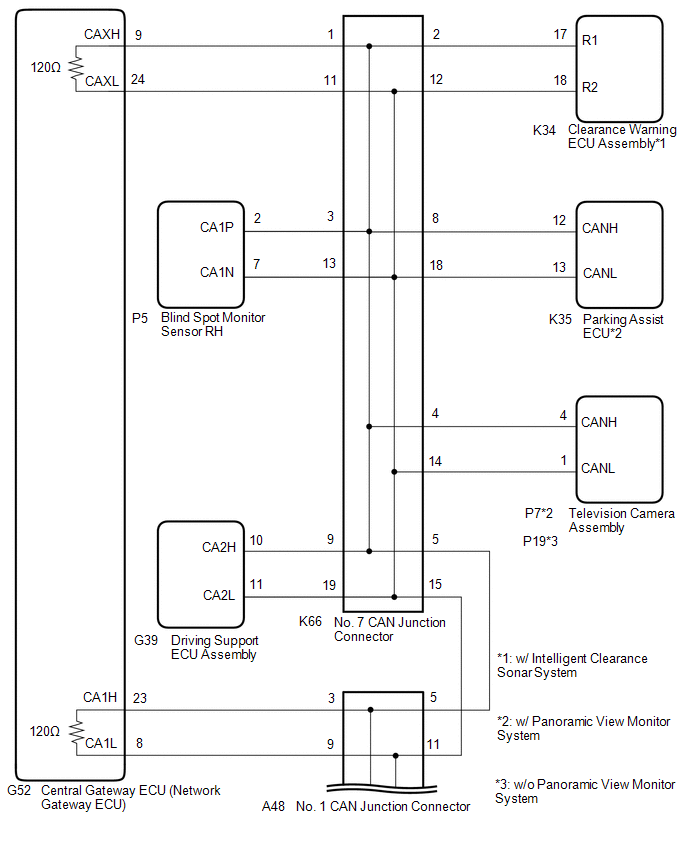
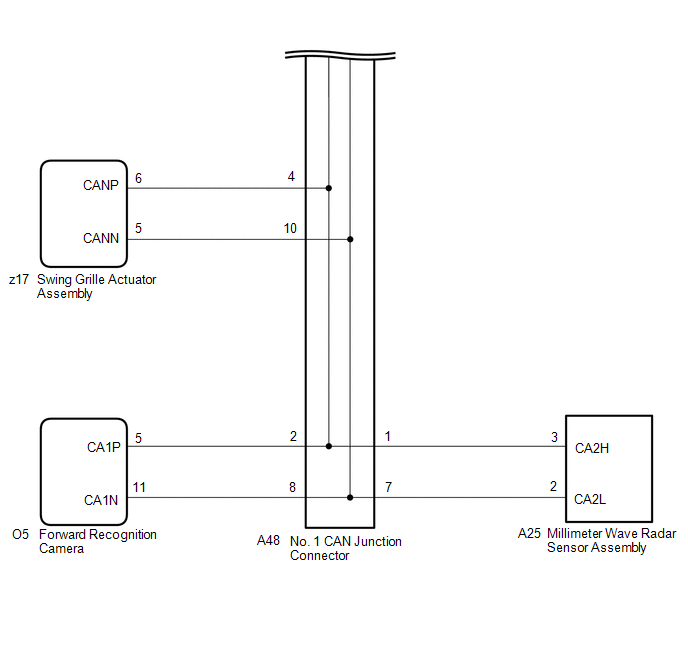
CAUTION / NOTICE / HINT
CAUTION:
When performing the confirmation driving pattern, obey all speed limits and traffic laws.
NOTICE:
HINT:
- Before disconnecting related connectors for inspection, push in on each
connector body to check that the connector is not loose or disconnected.
- When a connector is disconnected, check that the terminals and connector body are not cracked, deformed or corroded.
PROCEDURE
|
1. | CHECK FOR SHORT TO +B IN CAN BUS LINE (NO. 1 CAN JUNCTION CONNECTOR) |
(a) Disconnect the cable from the negative (-) auxiliary battery terminal.
(b) Disconnect the A48 No. 1 CAN junction connector.
(c) Measure the resistance according to the value(s) in the table below.

|
*1 | DLC3 |
- | - |
|
*a | Front view of wire harness connector
(to No. 1 CAN Junction Connector) |
*b | to Millimeter Wave Radar Sensor Assembly |
|
*c | to Forward Recognition Camera |
*d | to Central Gateway ECU (Network Gateway ECU) |
|
*e | to Swing Grille Actuator Assembly |
*f | to No. 7 CAN Junction Connector |
Standard Resistance:
|
Tester Connection | Condition |
Specified Condition | Connected to |
|
A48-1 (CANH) - G45-16 (BAT) |
Cable disconnected from negative (-) auxiliary battery terminal |
6 kΩ or higher |
Millimeter wave radar sensor assembly |
|
A48-7 (CANL) - G45-16 (BAT) |
|
A48-2 (CANH) - G45-16 (BAT) |
Cable disconnected from negative (-) auxiliary battery terminal |
6 kΩ or higher |
Forward recognition camera |
|
A48-8 (CANL) - G45-16 (BAT) |
|
A48-3 (CANH) - G45-16 (BAT) |
Cable disconnected from negative (-) auxiliary battery terminal |
6 kΩ or higher |
Central gateway ECU (network gateway ECU) |
|
A48-9 (CANL) - G45-16 (BAT) |
|
A48-4 (CANH) - G45-16 (BAT) |
Cable disconnected from negative (-) auxiliary battery terminal |
6 kΩ or higher |
Swing grille actuator assembly |
|
A48-10 (CANL) - G45-16 (BAT) |
|
A48-5 (CANH) - G45-16 (BAT) |
Cable disconnected from negative (-) auxiliary battery terminal |
6 kΩ or higher |
No. 7 CAN junction connector |
|
A48-11 (CANL) - G45-16 (BAT) |
|
Result | Proceed to |
|
OK | A |
|
NG (Line to central gateway ECU (network gateway ECU)) |
B |
| NG (Line to No. 7 CAN junction connector) |
C |
| NG (Line to ECU or sensor) |
D |
| A |
 | REPLACE NO. 1 CAN JUNCTION CONNECTOR |
| C |
 | GO TO STEP 3 |
| D |
 | GO TO STEP 5 |
|
B |
 | |
| 2. |
CHECK FOR SHORT TO +B IN CAN BUS LINE (NO. 1 CAN JUNCTION CONNECTOR - CENTRAL GATEWAY ECU (NETWORK GATEWAY ECU)) |
(a) Disconnect the G52 central gateway ECU (network gateway ECU) connector.
(b) Measure the resistance according to the value(s) in the table below.
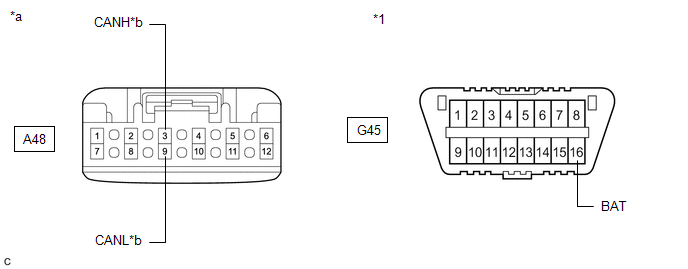
|
*1 | DLC3 |
- | - |
|
*a | Front view of wire harness connector
(to No. 1 CAN Junction Connector) |
*b | to Central Gateway ECU (Network Gateway ECU) |
Standard Resistance:
|
Tester Connection | Condition |
Specified Condition |
|
A48-3 (CANH) - G45-16 (BAT) |
Cable disconnected from negative (-) auxiliary battery terminal |
6 kΩ or higher |
|
A48-9 (CANL) - G45-16 (BAT) |
| OK |
 | REPLACE CENTRAL GATEWAY ECU (NETWORK GATEWAY ECU) |
| NG |
 | REPAIR OR REPLACE CAN MAIN BUS LINE OR CONNECTOR (NO. 1 CAN JUNCTION CONNECTOR - CENTRAL GATEWAY ECU (NETWORK GATEWAY ECU)) |
| 3. |
CHECK FOR SHORT TO +B IN CAN BUS LINE (NO. 7 CAN JUNCTION CONNECTOR) |
(a) Disconnect the K66 No. 7 CAN junction connector.
(b) Measure the resistance according to the value(s) in the table below.
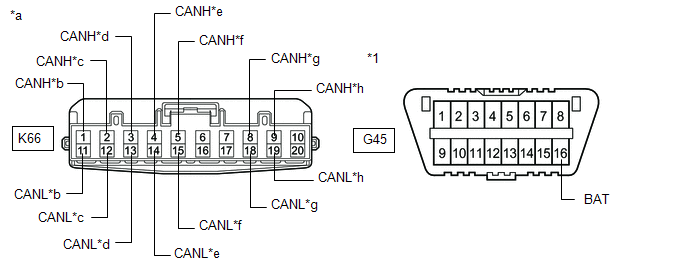
|
*1 | DLC3 |
- | - |
|
*a | Front view of wire harness connector
(to No. 7 CAN Junction Connector) |
*b | to Central Gateway ECU (Network Gateway ECU) |
|
*c | to Clearance Warning ECU Assembly
(w/ Intelligent Clearance Sonar System) |
*d | to Blind Spot Monitor Sensor RH |
|
*e | to Television Camera Assembly |
*f | to No. 1 CAN Junction Connector |
|
*g | to Parking Assist ECU
(w/ Panoramic View Monitor System) |
*h | to Driving Support ECU Assembly |
Standard Resistance:
|
Tester Connection | Condition |
Specified Condition | Connected to |
|
K66-1 (CANH) - G45-16 (BAT) |
Cable disconnected from negative (-) auxiliary battery terminal |
6 kΩ or higher |
Central gateway ECU (network gateway ECU) |
|
K66-11 (CANL) - G45-16 (BAT) |
|
K66-2 (CANH) - G45-16 (BAT) |
Cable disconnected from negative (-) auxiliary battery terminal |
6 kΩ or higher |
Clearance warning ECU assembly*1 |
|
K66-12 (CANL) - G45-16 (BAT) |
|
K66-3 (CANH) - G45-16 (BAT) |
Cable disconnected from negative (-) auxiliary battery terminal |
6 kΩ or higher |
Blind spot monitor sensor RH |
|
K66-13 (CANL) - G45-16 (BAT) |
|
K66-4 (CANH) - G45-16 (BAT) |
Cable disconnected from negative (-) auxiliary battery terminal |
6 kΩ or higher |
Television camera assembly |
|
K66-14 (CANL) - G45-16 (BAT) |
|
K66-5 (CANH) - G45-16 (BAT) |
Cable disconnected from negative (-) auxiliary battery terminal |
6 kΩ or higher |
No. 1 CAN junction connector |
|
K66-15 (CANL) - G45-16 (BAT) |
|
K66-8 (CANH) - G45-16 (BAT) |
Cable disconnected from negative (-) auxiliary battery terminal |
6 kΩ or higher |
Parking assist ECU*2 |
|
K66-18 (CANL) - G45-16 (BAT) |
|
K66-9 (CANH) - G45-16 (BAT) |
Cable disconnected from negative (-) auxiliary battery terminal |
6 kΩ or higher |
Driving support ECU assembly |
|
K66-19 (CANL) - G45-16 (BAT) |
- *1: w/ Intelligent Clearance Sonar System
- *2: w/ Panoramic View Monitor System
|
Result | Proceed to |
|
OK | A |
|
NG (Line to central gateway ECU (network gateway ECU)) |
B |
| NG (Line to No. 1 CAN junction connector) |
C |
| NG (Line to ECU or sensor) |
D |
| A |
 | REPLACE NO. 7 CAN JUNCTION CONNECTOR |
| C |
 | REPAIR OR REPLACE CAN MAIN BUS LINE OR CONNECTOR (NO. 7 CAN JUNCTION CONNECTOR - NO. 1 CAN JUNCTION CONNECTOR) |
| D |
 | GO TO STEP 5 |
|
B |
 | |
| 4. |
CHECK FOR SHORT TO +B IN CAN BUS LINE (NO. 7 CAN JUNCTION CONNECTOR - CENTRAL GATEWAY ECU (NETWORK GATEWAY ECU)) |
(a) Disconnect the G52 central gateway ECU (network gateway ECU) connector.
(b) Measure the resistance according to the value(s) in the table below.
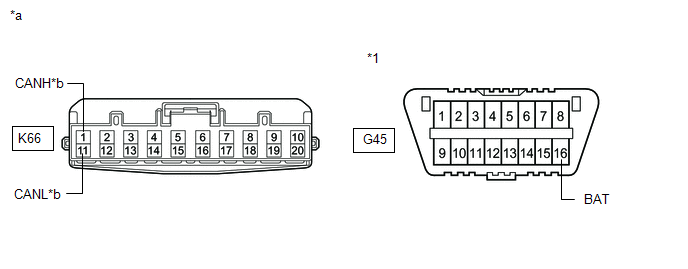
|
*1 | DLC3 |
- | - |
|
*a | Front view of wire harness connector
(to No. 7 CAN Junction Connector) |
*b | to Central Gateway ECU (Network Gateway ECU) |
Standard Resistance:
|
Tester Connection | Condition |
Specified Condition |
|
K66-1 (CANH) - G45-16 (BAT) |
Cable disconnected from negative (-) auxiliary battery terminal |
6 kΩ or higher |
|
K66-11 (CANL) - G45-16 (BAT) |
| OK |
 | REPLACE CENTRAL GATEWAY ECU (NETWORK GATEWAY ECU) |
| NG |
 | REPAIR OR REPLACE CAN MAIN BUS LINE OR CONNECTOR (NO. 7 CAN JUNCTION CONNECTOR - CENTRAL GATEWAY ECU (NETWORK GATEWAY ECU)) |
| 5. |
CHECK FOR SHORT TO +B IN CAN BUS LINE (ECU OR SENSOR) |
(a) Reconnect all wire harness connectors.
(b)
Disconnect the connector that includes terminals CANH and CANL from the
ECU or sensor to which the bus line shorted to +B is connected.
Click here

(c) Measure the resistance according to the value(s) in the table below.
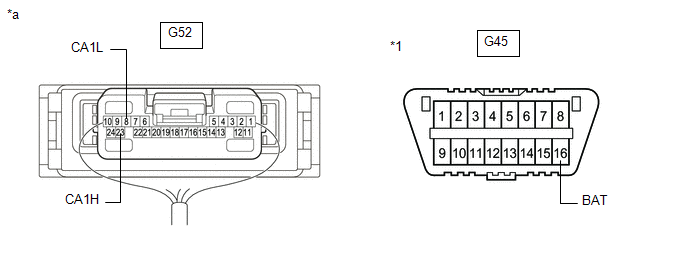
|
*1 | DLC3 |
- | - |
|
*a | Component with harness connected
(Central Gateway ECU (Network Gateway ECU)) |
- | - |
Standard Resistance:
|
Tester Connection | Condition |
Specified Condition |
|
G52-23 (CA1H) - G45-16 (BAT) |
Cable disconnected from negative (-) auxiliary battery terminal |
6 kΩ or higher |
|
G52-8 (CA1L) - G45-16 (BAT) |
HINT:
- If the resistance changes to 6 kΩ or higher when the connector is
disconnected from the ECU or sensor, there may be a short in the ECU or
sensor.
- If the resistance does not become normal when the connector is
disconnected from the ECU or sensor, check for a short to +B in the wire
harness and repair or replace the wire harness or connector if
necessary.
| OK |
 | REPLACE ECU OR SENSOR |
| NG |
 | REPAIR OR REPLACE HARNESS OR CONNECTOR |



















































